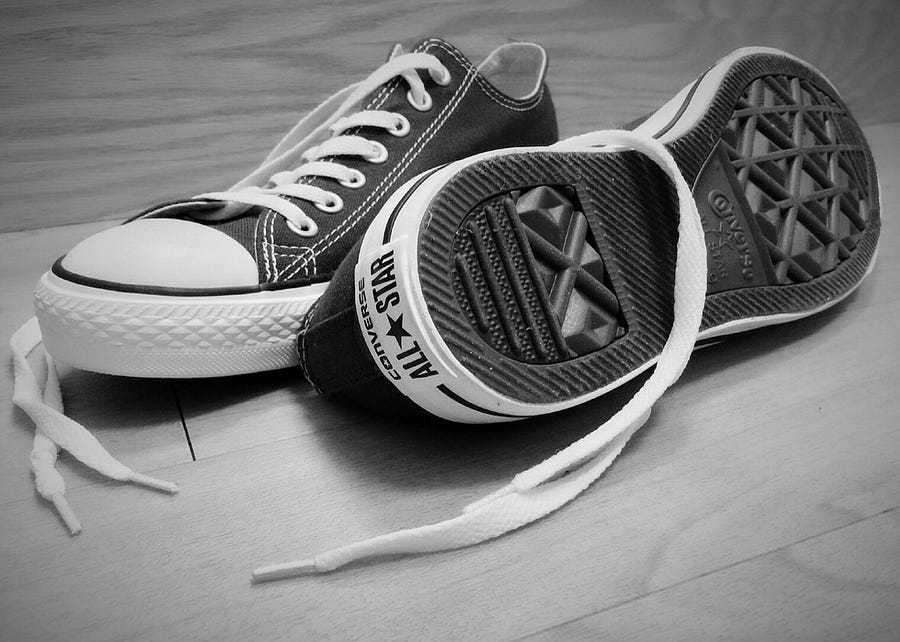Why Are Shoes Called Sneakers?
Where did the term sneakers come from, and was it really about sneaking?
Everyone has probably owned a pair of these shoes to wear for day-to-day activities or a sporting event. I’m talking about sneakers, the footwear of choice for those on the go in one form or another. But where did the term sneakers come from, and was it really about sneaking?
The origin of footwear we know as sneakers had its beginnings in an 1862 book titled Female Life in Prison, By a Prison Matron. In the first volume of the two-volume set of books written by Frederick Robinson about prison life for females in England in the 19th century, Robinson uses the word “sneaks” to refer to the shoes worn by the prison guards (matrons). Here’s the quote from the original text.
The night-officer is generally accustomed to wear a species of India-rubber shoes or goloshes. These are termed “sneaks” by the women. (Female Life in Prison, 1862)
The use of the word “sneak” didn’t start here, however. The word itself has been around since the 16th century, meaning essentially the same thing it does today, such as to move stealthily or act in a furtive manner. However, this 1862 reference was the first to refer to a type of shoe.
Another book published in England twelve years later also referenced the “sneak” as a type of shoe. James Greenwood wrote the book In Strange Company in 1874 and referred to a sneak as a shoe with a canvas top and India-rubber sole. By the turn of the century, the word “sneaker” had become commonly used in the United States.
The sneaker actually started as something known as the sand shoe. It was manufactured by the Liverpool Rubber Company in the 1830s. It, too, had a canvas upper with a rubber bottom. These shoes eventually gained the nickname “plimsoll shoes” in the late 1800s and were named as such because of the Plimsoll line, a line on a ship that indicates the safe, legal load to be carried. The horizontal band that joined the upper to the sole resembled this line. Incidentally, the Plimsoll line was named for the man who devised it, Samuel Plimsoll.
While these shoes became known as plimsolls, their modern usage in the UK today is trainers. The term sneaker somehow found its way across the Atlantic and became the word for this type of shoe in North America.
In the US, the sneaker gained popularity with the Keds brand that was manufactured by US Rubber in 1917. The original name was going to be Peds, but another company had already trademarked it. Keds, and later Converse with their iconic Chuck Taylor sneakers, dominated the sneaker market after this time.
There have been claims, however, that Keds were the first sneakers. An often-cited reference is from an advertising agent named Henry Nelson McKinney, who supposedly coined the term “sneakers” in 1917 to describe how quiet the shoes were. This, in fact, was found to be false by Andrew Adams Newman of the New York Times.
Newman discovered that the use of the word “sneakers” had been used in the US as far back as 1887. He found that the Boston Journal of Education had referenced sneakers with the statement, “It is only the harassed schoolmaster who can fully appreciate the pertinency of the name boys give to tennis shoes — sneakers.” A further search revealed that ads for tennis shoes were already being referred to as sneakers as early as 1889. It became apparent then that the term “sneaker” was already being widely used in the US before Keds began to dominate the market.
Bonus: Why Are Detectives Called Gumshoes?
While a gumshoe refers to a rubber-soled shoe worn by a detective and later refers to a detective, the association is still unclear. The first reference was in 1863, but it didn’t have anything to do with detectives. It instead referred to rubber shoes used in water.
The first mention of it being associated with detective work was in 1906, in a book by Alfred Henry Lewis titled Confessions of a Detective. It’s thought that since the rubber-soled shoes were quiet, this associated it with detective work, but there is nothing that specifically explains why detectives are known as gumshoes.
Sources: Hathi Trust, Textiles in Sport, Inventors About.com, Word Detective, Dr. Pribut, Online Etymology, New York Times, Take Our Word For It





